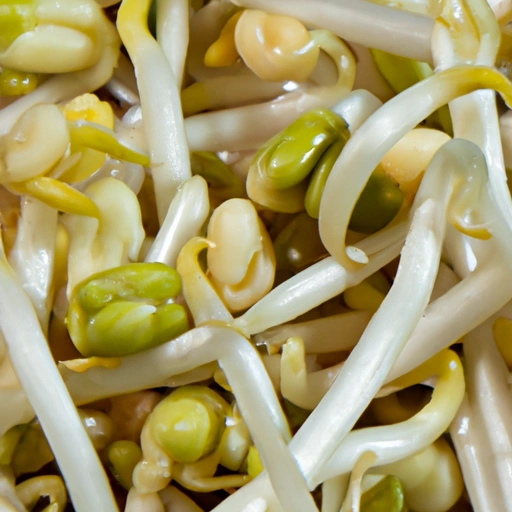Mung Bean Sprout
Description

Mung bean sprouts are the tender, edible shoots that emerge from germinated mung beans, known scientifically as Vigna radiata. These sprouts are a staple in many Asian cuisines and are celebrated for their crisp texture and mild, slightly sweet flavor. They are a versatile ingredient that can be used both raw and cooked, lending themselves well to a variety of dishes. In terms of measurements, mung bean sprouts are often used by the handful or cup in recipes, with a standard cup measure being approximately 104 grams or 3.7 ounces.
Common uses
Mung bean sprouts are commonly used as a fresh component in salads, sandwiches, and wraps. They can also be found stir-fried with meats and vegetables, incorporated into spring rolls, or used as a crunchy topping for soups and noodle dishes. Their light and refreshing quality make them a popular choice for health-conscious consumers and those looking to add a nutritious crunch to their meals.
Nutritional value
Calories
With only about 31 calories per cup (104g / 3.7 oz), mung bean sprouts are a low-calorie food ideal for weight management.
Protein
They offer about 3 grams of protein per cup, making them a valuable plant-based protein source.
Fat
Mung bean sprouts contain a negligible amount of fat, with less than 0.5 grams per cup.
Carbohydrates
They are composed of about 6 grams of carbohydrates per cup, which includes dietary fiber that supports digestive health.
Vitamins
Rich in vitamin C, mung bean sprouts provide about 14 mg per cup. They are also a good source of B vitamins, particularly folate.
Minerals
Mung bean sprouts contain minerals such as potassium, iron, and magnesium, essential for various bodily functions.
Health benefits
The high nutrient density and low-calorie count of mung bean sprouts contribute to numerous health benefits. They are known to support immune function, aid in digestion, and may play a role in reducing the risk of chronic diseases due to their antioxidant properties. Additionally, their high fiber content can help maintain a healthy gut microbiome and support cardiovascular health.
Potential risks
While mung bean sprouts are generally safe to eat, they should be washed thoroughly to reduce the risk of bacterial contamination. Consuming raw or improperly cooked sprouts can potentially lead to foodborne illnesses. Individuals with compromised immune systems may want to avoid raw sprouts and opt for cooked ones instead.
Common recipes
Common recipes featuring mung bean sprouts include pad Thai, pho, bibimbap, and various stir-fries. They are also a staple in vegetarian and vegan dishes as a protein-rich ingredient.
Cooking methods
Mung bean sprouts can be blanched, boiled, stir-fried, or eaten raw. They should be cooked briefly to maintain their crispness and nutritional value.
Pairing with other ingredients
These sprouts pair well with soy sauce, garlic, chili, ginger, and a variety of vegetables such as bell peppers, scallions, and carrots. They also complement proteins like tofu, chicken, or beef.
Summary
Mung bean sprouts are a nutritious, crunchy, and flavorful ingredient that can enhance a multitude of dishes with their health benefits and culinary versatility. Whether used in traditional Asian recipes or modern fusion cuisine, they offer a delightful texture and a host of nutrients that make them a valuable addition to any meal.